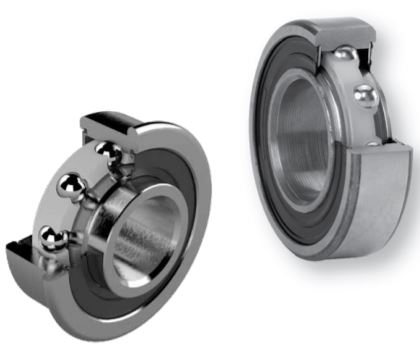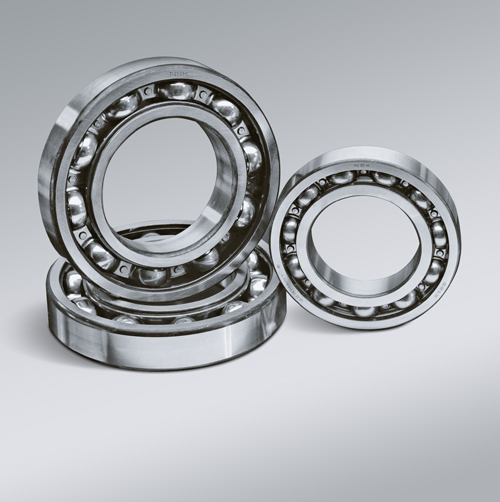What are the challenges and solutions for managing radial loads and axial loads in deep groove ball bearings?
Managing both radial loads and axial loads in deep groove ball bearings can present certain challenges. However, there are solutions available to address these challenges effectively. Here’s a detailed explanation of the challenges and solutions for managing radial loads and axial loads in deep groove ball bearings:
- Challenges:
- Increased contact pressure and localized stress on the raceways due to axial loads
- Potential ball skidding or sliding under high axial loads, leading to uneven wear
- Risk of ball and raceway deformation or brinelling under excessive axial loads
- Solutions:
- Proper Bearing Selection: Selecting deep groove ball bearings that are designed to handle both radial and axial loads is crucial. Bearings with higher axial load capacities, such as deep groove ball bearings with filling slots or angular contact ball bearings, may be suitable for applications with significant axial loads.
- Optimized Internal Clearance: The internal clearance of the bearing can be adjusted to accommodate the expected radial and axial loads. This ensures optimal load distribution and minimizes the risk of excessive stress concentrations. Manufacturers provide guidelines on the appropriate internal clearance for different load conditions.
- Bearing Preload: Preloading the bearings can help manage axial loads by applying a controlled amount of internal axial force. This ensures that the bearings maintain contact with the raceways and minimizes the risk of ball skidding or sliding. Preloading is commonly used in applications such as machine tools.
- Use of Thrust Bearings: In applications with high axial loads, incorporating thrust bearings in conjunction with deep groove ball bearings can help manage the axial component effectively. Thrust bearings are designed specifically to handle axial loads and can be used in combination with deep groove ball bearings to support both radial and axial loads.
- Design Considerations: Careful consideration of the application’s operating conditions, load magnitudes, and directions is essential. This includes analyzing the ratio of radial to axial loads, the presence of shock or impact loads, and any misalignment or angular loads that may affect bearing performance. By understanding the specific requirements, the bearing arrangement and selection can be optimized for improved load management.
Deep groove ball bearings are primarily designed to handle radial loads. When subjected to significant axial loads, they may experience increased stress and premature wear, potentially leading to bearing failure. The challenges in managing radial loads and axial loads include:
To effectively manage radial loads and axial loads in deep groove ball bearings, the following solutions can be implemented:
In summary, managing radial loads and axial loads in deep groove ball bearings requires careful consideration and appropriate solutions. Proper bearing selection, optimized internal clearance, bearing preload, the use of thrust bearings, and design considerations tailored to the application’s requirements are key steps in effectively managing both radial and axial loads. By implementing these solutions, the performance and longevity of deep groove ball bearings can be maximized, ensuring reliable operation under varying load conditions.
How does proper lubrication impact the performance and longevity of deep groove ball bearings?
Proper lubrication plays a crucial role in determining the performance and longevity of deep groove ball bearings. Here’s a detailed explanation of how proper lubrication impacts these aspects:
- Reduced Friction and Wear:
- Heat Dissipation:
- Corrosion and Contamination Protection:
- Noise and Vibration Reduction:
- Effective Load Distribution:
- Preservation of Bearing Integrity:
Lubrication creates a thin film of lubricant between the rolling elements and the raceway surfaces of the deep groove ball bearing. This film of lubricant reduces friction and minimizes metal-to-metal contact, resulting in lower wear and extending the bearing’s lifespan. Proper lubrication ensures that the lubricant film remains intact, preventing excessive friction, heat generation, and premature wear of the bearing components.
Deep groove ball bearings can generate heat during operation due to the sliding and rolling contact between the balls and the raceways. Adequate lubrication helps in dissipating this heat by carrying it away from the contact zone. Proper lubrication prevents the bearing from overheating, which can lead to accelerated wear, loss of dimensional stability, and even bearing failure.
Lubrication provides a protective barrier against corrosion and contamination. The lubricant helps to seal the bearing against external elements such as moisture, dust, dirt, and other contaminants that can degrade the bearing surfaces and compromise its performance. By preventing corrosion and contamination, proper lubrication extends the bearing’s service life and ensures reliable operation in challenging environments.
Insufficient or improper lubrication can result in increased noise and vibration levels in deep groove ball bearings. The lubricant acts as a cushioning medium, absorbing shocks and reducing the transmission of vibrations. Proper lubrication minimizes the generation of noise and vibrations, resulting in smoother and quieter operation of the bearing.
Proper lubrication ensures effective load distribution within the deep groove ball bearing. The lubricant film helps distribute the applied loads evenly across the rolling elements and raceways, minimizing stress concentrations and preventing premature fatigue or failure of the bearing. This promotes the bearing’s load-carrying capacity and enhances its overall performance and reliability.
Adequate lubrication helps preserve the overall integrity of deep groove ball bearings. It reduces the risk of surface damage, pitting, and scoring, which can lead to accelerated wear and premature failure. Proper lubrication also prevents the formation of rust and corrosion, preserving the structural integrity of the bearing components and ensuring their long-term functionality.
In summary, proper lubrication of deep groove ball bearings is essential for reducing friction and wear, dissipating heat, protecting against corrosion and contamination, minimizing noise and vibrations, facilitating effective load distribution, and preserving the overall integrity of the bearing. By ensuring proper lubrication, the performance and longevity of deep groove ball bearings can be significantly enhanced, resulting in reliable operation and extended service life.
Can you explain the role of shields and seals in preventing contamination of deep groove ball bearings?
Shields and seals play a critical role in preventing contamination of deep groove ball bearings. These protective components act as barriers, preventing the ingress of contaminants such as dust, dirt, moisture, and other harmful substances into the bearing’s internal components. Here’s a detailed explanation of the role of shields and seals in preventing contamination of deep groove ball bearings:
- Shield:
- Seal:
- Preventing Contamination:
- Selection and Maintenance:
A shield is a metallic or non-metallic disc that is typically made of steel, synthetic rubber, or a combination of materials. It is designed to cover a portion of the bearing’s outer ring, leaving a small gap between the shield and the inner ring. The primary function of a shield is to provide a physical barrier that blocks the entry of contaminants into the bearing. Shields are effective in preventing larger particles, such as dirt and debris, from reaching the bearing’s internal components while allowing grease or lubricant to flow within the bearing.
A seal is a flexible component typically made of rubber or synthetic materials. It is designed to completely enclose the bearing and create a tight seal between the outer and inner rings. Seals create a physical barrier that effectively blocks contaminants from entering the bearing. Unlike shields, seals provide a higher level of protection against fine particles, moisture, and other contaminants by forming a more complete seal around the bearing. This helps to maintain the integrity of the lubricant and reduce the risk of premature wear or damage to the bearing’s internal components.
Contamination is a major cause of premature bearing failure. When contaminants such as dirt, dust, or moisture enter the bearing, they can interfere with the lubrication, cause abrasive wear, or induce corrosion. This can lead to increased friction, heat generation, and accelerated wear, ultimately compromising the bearing’s performance and lifespan. Shields and seals act as protective barriers that prevent these contaminants from reaching the critical internal components of the bearing, preserving the lubricant’s integrity and maintaining a clean operating environment for the rolling elements and raceways.
Proper selection and maintenance of shields and seals are essential for their effectiveness in preventing contamination. It is important to choose shields or seals that are suitable for the specific application and operating conditions. Factors such as the type and size of contaminants, temperature variations, and rotational speeds should be considered when selecting the appropriate shielding or sealing solution. Regular inspection and maintenance of shields and seals are also important to ensure they remain in good condition. Damaged or worn shields or seals should be promptly replaced to maintain the bearing’s protection against contamination.
In conclusion, shields and seals play a crucial role in preventing contamination of deep groove ball bearings. By acting as protective barriers, they safeguard the bearing’s internal components from the ingress of contaminants, preserving the lubrication, reducing wear, and extending the bearing’s service life. Proper selection, installation, and maintenance of shields and seals are essential to ensure their effectiveness in maintaining a clean and contaminant-free environment within the bearing.
editor by CX 2024-04-23



